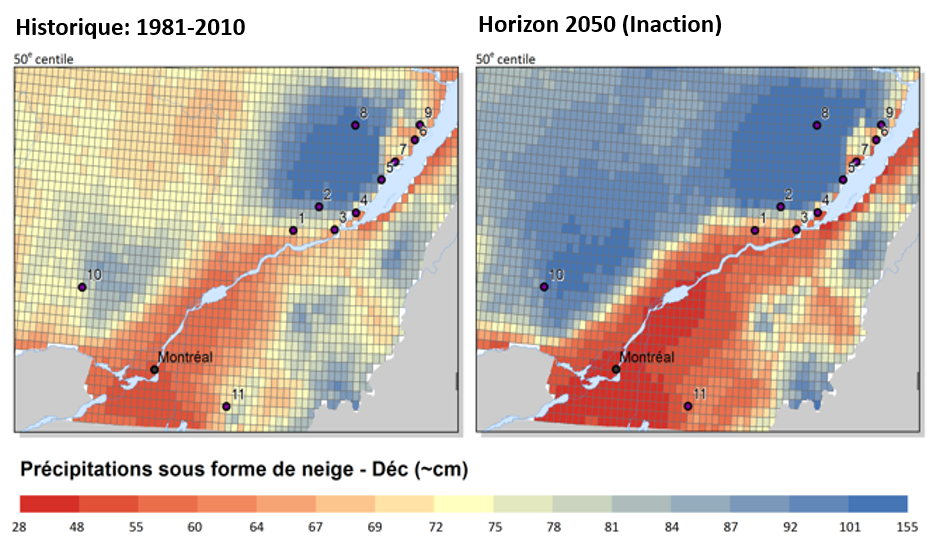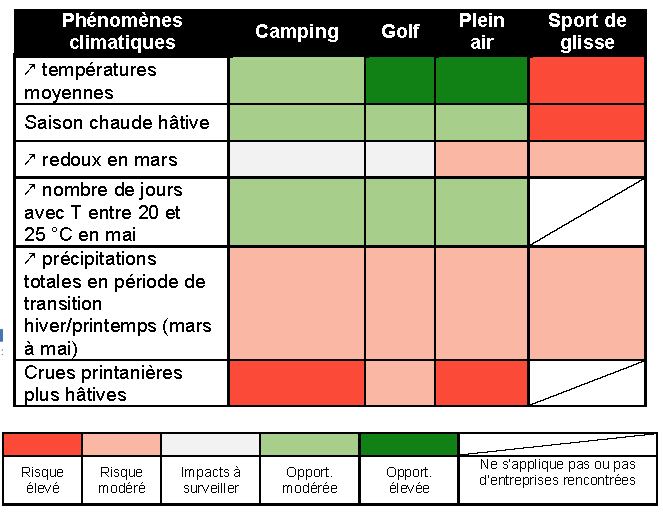Analysis of climate change risks and opportunities for the Quebec city and Charlevoix tourism sectors
The collaborative approach increased awareness and the general uptake of knowledge related to climate change within the tourism sector and provided a better understanding of the perceptions, attitudes and behaviours of tourism stakeholders.
Project details
Principal(s) investigator(s)


Context
In Québec, few studies identify the business risks and opportunities arising from climate change. Building on the mobilization of the tourism sector that began with a study in 2012, this project examines two regions of major economic importance that account for 15% of the province’s tourist volume. The four-season offering provides a variety of customer experiences, some of which are world-class.
Several key components for business viability, such as image, clientele, operations and employment, business and investment strategies, and attractiveness of tourist attractions and landscapes, are directly affected by the unpredictable nature of extreme weather events and interannual season variability. Climate change will have both positive and negative impacts in this regard.
This project is a continuation of research work aimed at determining the importance of climate conditions as a factor in the decision-making and operational processes of tourism businesses, and in managing future risks and opportunities for tourism businesses in the sectors under study in this project (agritourism, camping, events, golf, snowmobiling, outdoor recreation and sliding sports).
Objective(s)
-
Conduct a regional vulnerability analysis (risks/opportunities) of the Québec City and Charlevoix tourism sectors.
Methodology
-
Use participatory research-action to strengthen the mobilization process;
-
Conduct a literature review and collect secondary socioeconomic data and climate impact data;
-
Use different investigation methods (interviews, workshops, surveys) to gain an understanding of the impacts on the fields of activity of seasonal businesses;
-
Produce change simulations and scenarios for climate indicators relevant to the tourism sector;
-
Integrate and analyze the results and produce a risk/opportunity matrix;
-
Communicate and transfer up-to-date scientific knowledge.
Results
Seven sectors of activity were examined and compared: agritourism, camping, events, golf, snowmobiling, outdoor recreation and sliding sports. While it is a strategic issue, climate risk remains marginal for business managers, who often act in response to the seasonality and unpredictability of extreme hydroclimatic events. To address the lack of specialized information linking tourism and climate, new climate mapping tools and analyses for use in decision making have been developed to help prepare the tourism industry for climate change.
The identification of important variables by surveyed tourism managers, the development of monthly climate indicators applicable to the sectors under study and the production of a risk/opportunity matrix are among the major advances made in comparison to previous studies (Figure 1 and Table 1). These decision support tools were created to mobilize and raise the level of awareness of tourism stakeholders and support strategic planning within the sector in response to the changes in climate anticipated by 2050.

Figure 1 : Precipitation in the form of snow in December for the reference climate 1981-2010 (left) and 2041-2070 time horizon (right) under the “Inaction” scenario (greenhouse gas emissions scenario with no adaptation measures, commonly known as “Business as usual” scenario)

Table 1 : Extract from the future risk/opportunity matrix for the spring in the Charlevoix region
The results show that seasonal activities are vulnerable to climate conditions, but can also benefit from climate change. For example, by 2050, the warm season will tend to be longer, which could be beneficial for certain seasonal practices such as agritourism, outdoor recreational activities, and event organization at times of year that have been hitherto underexploited, such as the fall. In winter, inland areas and those at higher altitudes will continue to receive abundant snowfall relative to areas along the St. Lawrence River. The winter season will remain a significant competitive advantage for the Québec City and Charlevoix regions compared to the northeastern United States, Ontario and southern Québec.
Thus, the parties concerned by the study have everything to gain by focusing on dialogue, diversifying their activities, and ensuring complementarity of the tourism offer on the regional level. The tourism industry would benefit from considering known climate risks in its decision-making processes, while integrating identified business opportunities, in order to remain competitive, better invest in the long term, and maintain the integrity and sustainability of tourist assets.
Benefits for adaptation
Benefits for adaptation
The collaborative approach increased awareness and the general uptake of knowledge related to climate change within the tourism sector and provided a better understanding of the perceptions, attitudes and behaviours of tourism stakeholders.
The tourism sector now has strategic climate knowledge that will be useful to public and private tourism stakeholders, an opportunity to boost capacities within sectors and regions to adapt and to develop decision-making skills regarding risk management and adaptation.
This analysis and the various visual products created under the project will contribute to more informed decision-making by SMEs, destinations, the Ministry of Tourism and regional economic development agencies.
This portrait provides a solid foundation for ongoing regional dialogue and for working with stakeholders on achievable adaptation initiatives.
Scientific publications
Funding










